
Database
Published
Response
Back to
GiantDatabase.com
|
Thomas Builds A Fire Piston
In this episode Thomas wants to light a fire under his
foe - the evil Dragamont. His current problem is that,
because he is a little kid, he's not allowed to use matches.
So he wants something that looks harmless that can still
light a fire. A few weeks ago, when his older brother
was home, he had talked about a really weird way to
start fires called the "fire piston".
His dad tells this story about fire pistons:
"Sometime after World War II there was a group
flying around in the Pacific Ocean. They hopped
from one island to the next - looking around and
meeting with the natives. At one stop, the pilot was
talking with some of the residents when one of them
whipped out a small stick-like device, hit it, and calmly
lit his cigarette. The pilot was amazed, "What the heck
did you just do?". After some negotiation, a trade of
one Zippo lighter and two pieces of Hubba-Bubba
bubble gum for the stick-like device was made. The
pilot flew away with an amazing "Fire Piston."
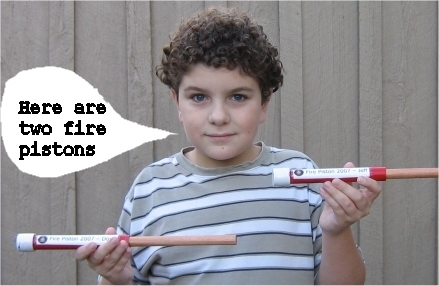
A way to start a fire using just air pressure? Even little
kids are allowed to use air pressure! Thomas G wanted
to make one. Or maybe two. Dad wanted to make twelve.
Parts List For Fire Piston
Thomas needs a dollar fifty for his share of the kit. He
makes the long walk to home improvement store on the
other side of the lake clutching his money and a parts list.
Parts To Make A Dozen Fire Pistons
------------------------------------------------
( 1) PCV pipe "half inch" and 10ft long $ 2.50
(12) PVC end caps for the pipe $ 2.50
(12) rubber "O" rings $3.00
( 4) hardwood dowels that fit in the pipe $10.00
PVC purple primer and cement $0.00
Vaseline or bacon fat $0.00
Char cloth or some other fancy tinder $0.00
------------------------------------------------
Enough parts for twelve fire pistons $18.00
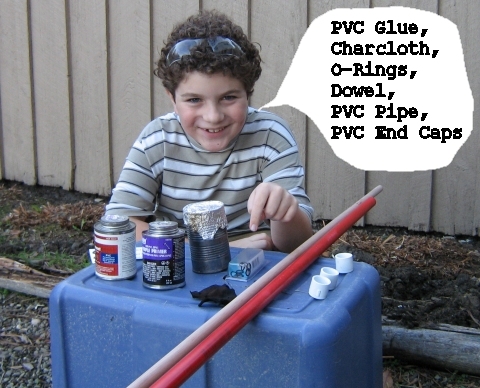
It helped that there was leftover PVC primer and cement from
the last project. Mom had some Vaseline for grease. Thomas
liked that idea better than dad's idea of using bacon fat (which
is gross). He even got some charcloth from his older brother.
Once again dad forgot to take a saw to cut the pipe so it
would fit inside the car. This time the pipe was thin and could
be bent and shoved into the car (still, riding home with a pipe
in front of your face is annoying). Remember to bring a saw!
Making The Fire Piston
Thomas knows about measuring pipe sizes. He also knows
how to put together tents and make hot chocolate. For this
project everybody on the team needs to know about "inside
diameter" and "outside diameter". If the pipe was really thin
then these two numbers would be almost the same.
A hacksaw cuts the PCV pipe to about 10 inches length.
Sandpaper helps to remove little plastic burrs from both ends.
On the open end, he rounds off the inside of the pipe so
the "O" ring loads smoothly.
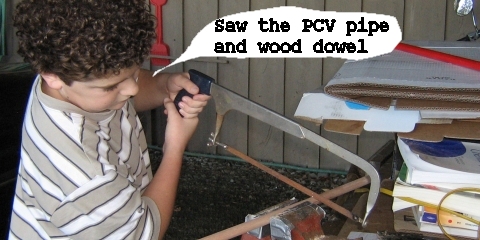
Cut the wooden dowel to about 16 inches. The dowel
has to be longer than the PCV pipe so that you can
grab it and pull it back out. A hacksaw may not be the
"perfect" tool but it does work on both PVC and wood.
Make sure the end cap goes totally onto the end of the
pipe.To get a good seal, Thomas put a little grease inside
the pipe on both ends (being careful not to get any grease
on the outside where the end cap will be glued).
PVC pipe takes a purple primer along with cement to
make a strong connection. Make sure you have good
ventilation as the purple primer and cement are smelly.
A little primer and glue go inside the end cap and outside
on one end of the pipe pipe. Quickly push the end cap
fully onto the pipe with a little twist. Leave it to dry.
Making an "O" ring seal that slides smoothly often takes
a few tries. This critical detail is the difference between a
fire piston that actually makes fires and one that does not.
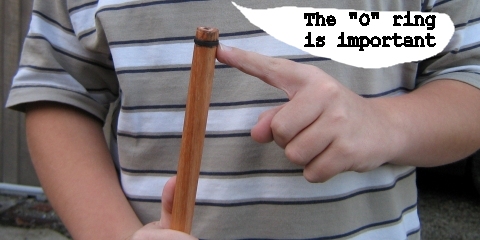
Try to make the perfect grove for the "O" ring - smooth
and just the right depth. Then lube it up with more Vaseline.
One sign of a good seal is that it "pops" when the dowel is
removed. A better seal will "bounce" and the dowel will
not bottom out when pushed. If it's too tight you can try
to sand off a little "O" ring material until it just fits.
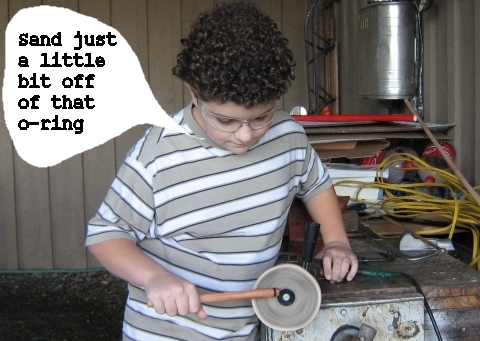
Expect to spend more effort on getting the "O" ring
seal working than on all the other parts combined.
Thomas was surprised (and annoyed) by the effort.
Finally, Thomas uses a drill to make a hole in the center
on the end of the dowel - this little hole is for charcloth.
Charcloth lights easily to become a glowing ember
when you blow on it (he goes for the fancy tinder this
time). Lighting fires using air pressure sounds hard
enough already so go for the best tinder.
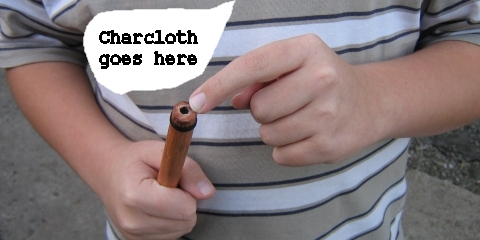
He tried longer and shorter pistons. Longer did not work
better. The shorter ones are nicer and portable. Just make
the PVC pipe long enough to get a good grip for firing.
Some people make little fire pistons out of hardwood
or other natural materials and sell them for $80. Thomas
wanted to buy one with his money from his bank account.
Dad decided that inexpensive PVC and easy "O" rings
were more appropriate for a little kid (=Dad is cheap).
Using The Fire Piston
Make sure your piston is dry and clean. Grease the "O"
ring and place a bit of charcloth in the hole at the end of
the dowel. Slide the plunger partway down into the pipe.
The strategy is simple: Hold the plastic end and smash it
down as hard as you can on a rock. If it does not work,
try smashing harder. When it's almost dark, you can see
the glow of ignition right thru the pipe. Dad also found
that you can hurt your arm testing too many pistons over
too few days because you smash so hard. Take it easy.
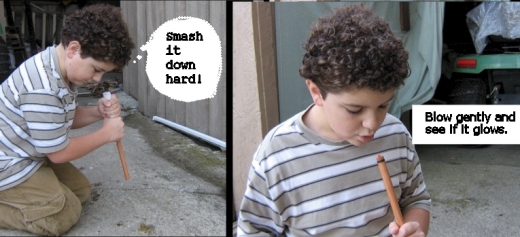
After all that effort in one instant to smash it down, pulling
out the dowel seemed to take forever. It looks like nothing
has happened until gentle blowing shows a beautiful orange
glow. Poke that charcloth ember into some more dry stuff
and away you go on making your fire.
It will be some time before Thomas gets the fire piston to
work. The project is easy to build but getting it to work is
another matter. Making the "O" ring seal just right and
then smashing it hard enough to light tinder is hard to do.
In the end Dragamont was not attacked. This time he got away.
Soon Thomas will develop the power to activate his fire piston.
By that time he might be allowed to use matches too.
Design Considerations From Dad:
Building a fire piston is the frosting on my fire starting kit.
Today the kit has: magnifying glass, magic spark stick,
dryer lint, bowsaw lighter, and drill lighter. No matches.
At first primitive fire starting seems impossible. After you
have done it yourself, it just seems difficult. Practice makes
difficult things easier. This project takes practice.
Science tidbit: Plain paper lights at about 450 degrees
Fahrenheit and a fire piston can create something like
800 degrees. This is hot enough to ignite charcloth
but it's not as hot as a match or spark.
Making charcloth is it's own little cooking exercise. I took
an old 100% cotton tshirt and cut it up into a dozen two inch
squares. You put the squares into a clean tin can and then
cover the top with tin foil to seal it. Punch just one pinprick
into the top of the foil and cook it with a propane torch for
about 5-10 minutes (or until the hole stops smoking).
Making fire with air pressure is an impressive trick when it
works but it's difficult to get a good "O" ring seal that has
just the right bounce. Even then you have to hit this thing
HARD to make it light. When the end glows just smile.
This project was inspired by Rob Bicevskis.
Model T Fire Piston
Notes for Talk on Fire Piston
----------------------------------------
Fire is a big deal for food and comfort and tool making.
In mythology Prometheus stole fire from Zeus and gave it to people.
It's going to be cold outside for month after month this winter.
One fire can be given away to start another without cost.
Here are five ways to start a file without matches:
magnifying glass, sparker, friction (bow/drill), fire piston.
Always need: Tinder - Kindling - Fuel or Birds Nest.
Practice makes it work for you.
Natural materials like wood or bone can be used to
make a much smaller fire piston than our monster
sized PVC version. The tip of the piston has a
small hole and behind the tip is usually a gasket
to ensure an airtight seal. Natural versions might
use waxed string where we use an O-ring.
To use a fire piston, you put a tiny piece of tinder
in the hole at the tip of the piston and apply a dab
of grease to the gasket. Insert the dowel into the
PVC pipe and smack it down rapidly.
The physics behind this is Charles Law about gases.
Smacking the piston compresses the air inside, which
raises its temperature. For an instant the temperature
at the tip of the piston can hit 800F and that's enough
to ignite the tinder. When the device is working
correctly, the piston does not bottom out and even
springs back after impact. Use a knife tip or twig
to transfer the ember to a larger pile of tinder or
birds nest and blow gently. Charcloth makes for
easy fire because it stays lit a long time.
Fire pistons work according to physical principle called
Charles law. This law says that the ratio of a gas
temperature to its volume and pressure is a constant.
So when you decrease the volume of a given quantity
of gas by compressing it, you increase its temperature;
by increasing the volume, you decrease its temperature.
Hey. Hit it HARD and it just might ignite.
This very principle is what makes diesel engines work.
The fuel is ignited by rapidly compressed air, not by a
spark plug. In fact, some people believe Rudolf Diesel
may have gotten the idea for his Diesel engine after
seeing a fire piston.
Real Answers
to Real Questions
Real Fast.
www.GiantDatabase.com
Send us your comments...
Project Of November 2007 (Picture resolution 480w x 240h)
|
BACK
|